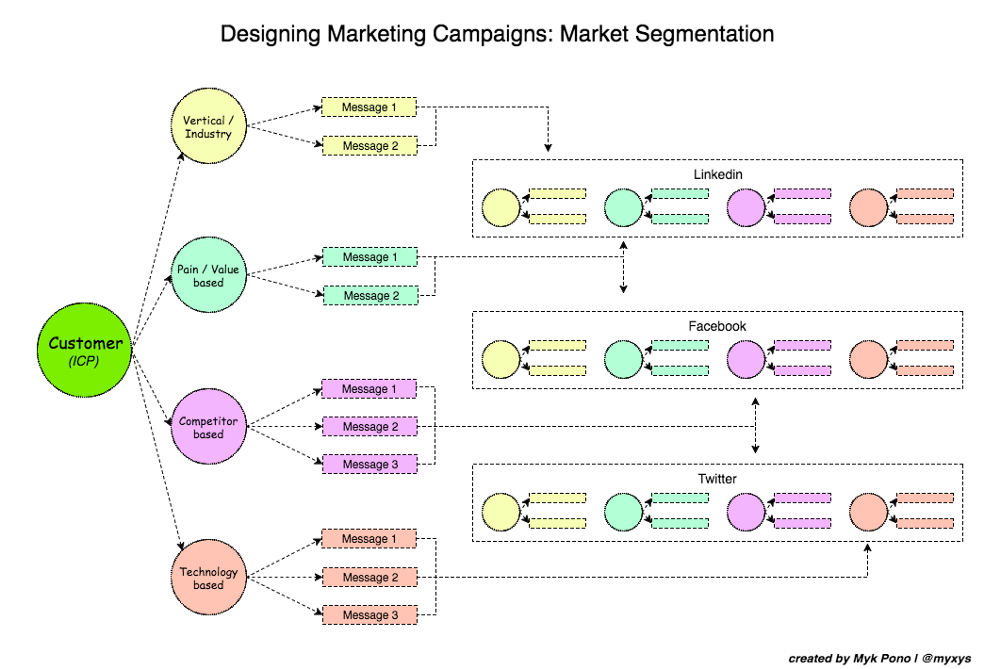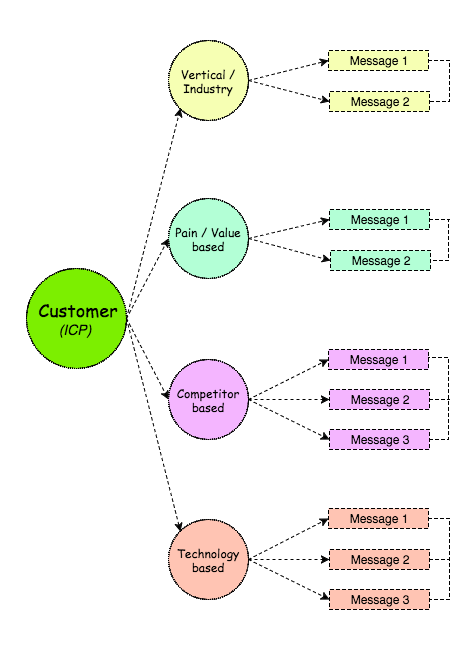In the past, marketers often employed a (rather unpleasantly named) strategy known as spray and pray. This involved marketing their business everywhere they could think of and to anyone who would listen. This kind of marketing was expensive, difficult to measure, and ineffective.
Spray and pray was often combined with batch and blast marketing, which involved creating one email blast and sending it to everyone on their customer list.
This was in the days before the General Data Protection Regulation (GDPR), so many unsuspecting customers ended up getting emails and other marketing communication that they hadn’t given their consent to receive.
Thankfully, most (but not all) companies have moved on and are using a more targeted and personalized approach to marketing. One of the tactics that savvy marketers are using is called market segmentation.
Overview: What is market segmentation?
Instead of having one huge customer list and sending every message you create to everyone on that list, market segmentation involves splitting customers with similar characteristics or interests into different groups.
Customers can be in multiple different market segments at once. You would then only send your marketing messages to the relevant segment(s).
What are the 4 types of market segmentation?
There are four main types of segmentation that you can use to split customers into more manageable groups. We run through these below and provide market segmentation examples for each one.
Type 1: Geographic segmentation
Location is one basic but important way to segment your customers.
For example, if you want to market ski goggles, you might want to create segments for people who live in states that get a lot of snow and that have particularly good ski resorts.
Or, when creating Thanksgiving promotions, you might want to create a simple segment for all your customers in the U.S.
Examples of geographic segmentation
Geographic segmentation can refer to both a specific location as well as the characteristics of that location. Here are some examples of both:
- Climate: It makes sense to only market certain items (such as ski products) to certain climates.
- Country: Different countries observe different holidays, so it’s important to make sure you’re sending emails that customers will understand.
- City: If you have brick-and-mortar stores, you might want to create promotions that are targeted at certain locations in specific cities.
Type 2: Demographic segmentation
This is one of the most popular methods that marketers use to segment customers, as it’s one of the easiest and quickest segments to set up.
Examples of demographic segmentation
It’s important to remember that some demographic information, such as age, is always changing, so you need to continually update your segments. Here are some examples of demographic segmentation:
- Age: You can target different products to different age groups, as well as use different marketing channels and content to cater to different generations.
- Gender: While gender is becoming a much less important target market, there are still occasions when you might (and we emphasize might) want to segment by gender, such as marketing pregnancy products toward women.
- Income: You could market your more expensive lines to customers with a higher income.
- Family situation: Someone who is pregnant or has children may be interested in different products than someone who is single.
Type 3: Behavioral segmentation
While it’s easy to collect geographical and demographical information, behavioral segmentation takes more work since you need to collect and analyze more data on your customers.
Examples of behavioral segmentation
To successfully create behavioral-based segments, you need to understand customer actions. Here are some examples of behavioral segments you can create:
- Past purchases: Has a customer bought your product or service before and, if so, was how recently?
- Brand loyalty: Do they regularly interact with your brand across different marketing channels or do they regularly buy your product?
- User status: Have they just signed up to your newsletter or have they stopped interacting with your brand?
Type 4: Psychographic segmentation
Psychographic segmentation is probably the most imprecise type of segmentation, but it also gives you the opportunity to show your customers that you care about them enough to take their interests into account.
Examples of psychographic segmentation
To understand how to create psychographic segments, you need to really listen to your customers so you can understand them better. Here are some examples of psychographic segmentation:
- Brand loyalty: Do certain customers particularly like certain brands? For example, if you sell sneakers, you could create a segment of everyone who likes Nike.
- Values and beliefs: Do you have customers who are vegan or who only buy organic sustainably made products?
- Lifestyle: Do certain customers like to spend a lot of money on certain products, or to buy them often? For example, some customers may want to spend a lot of money on a trendy suitcase, while others may see this as extravagant and only want to buy a basic model.
- Interests: If a customer has certain interests, then they might buy specific items more often and buy higher-value products. For example, keen runners will often spend more money on sneakers and buy them more frequently than non-runners.
How to create your own market segmentation
Now you know the different types of segments you can create, it’s time to get practical. Here are the steps you need to take if you want to segment your customer base.
Step 1: Unify your customer data
To create the most accurate, more specific segments, you need to ensure you are collecting as much information as you can on your customers. Record every interaction they have with you and every bit of information they share with you.
Once you have that data, you need to ensure that you store it all in one place, rather than keep your social media data in one location, your email marketing data in another, and your event data in yet another.
When you’ve unified this data, you can start to build up a complete picture of your customers and spot patterns.
For example, you might see that a lot of customers are clicking on articles about vegan skincare in your email newsletter. You can then create a segment of these customers and send them a discount code to encourage them to make a purchase.
Step 2: Create buyer personas
Your segments need to correspond with your business goals and your target market. There’s no point in creating segments of people who live in places where it snows a lot if you don’t sell winter wear.
Putting together buyer personas — which are fictional representations of your ideal customers, including their interests, favorite sites, and demographic data — can help you choose characteristics you want to create segments for.
For example, if your target customer has an income of over $80,000 a year or lives in a major city, then you can create a segment for each of those things.
Step 3: Do your research
Once you’ve created your buyer personas, you need to get as much information as you can on your current and potential customers.
Do keyword research to find out what they are searching for online. Look at what news websites they use or social media channels they favor.
Find out as much as you can on how your competitors segment their customers by signing up for their email newsletters, following them on social media, and browsing their websites.
Step 4: Talk to your customers
This step is particularly useful for psychographic segmentation. The best way to find out a customers’ interests, values, motivations, and beliefs is to ask them directly.
You could create a survey and email it to customers or post questions on social media asking for your customers’ opinions on certain topics. For example, you could ask how many of your customers are vegans.
Step 5: Use your website
Your website is one of your most important marketing channels and an incredibly useful sales and marketing tool, but it’s also often overlooked.
If you want to create behavioral segments, then you need to use your website data. What products or categories are people browsing the most? Which channels are they using to find your website? Which products are they buying?
This information can help you understand which kinds of segments you should be creating.
Step 6: Test, measure and repeat
There is no one magic bullet that will help you create your perfect segment. Some will yield results and some won’t, but you won’t know until you try. That’s why you need to create segments based on the steps above, test the success of your marketing messages against each segment, monitor the performance against your marketing KPIs, and make adjustments as needed.
Methods of market segmentation your small business should try
At The Blueprint, we want to make your life as easy as possible. That’s why we’ve compiled some methods and tools you can use to make the process of setting up customer segments much quicker and easier.
Invest in email list management
One useful way to segment your customers is to use your email list. Leading email marketing software lets you search for common characteristics and surfaces the results. You can then use this data to create segments with just one click.
Mailchimp takes this one step further by analyzing your customer data using its machine learning–based algorithm and building segments automatically based on customer behavior, such as how much time has passed since they last opened one of your campaigns.
For this to work, you need to ensure that you’re managing your email list, which is one of the most important email marketing best practices. This means adding and removing customers from the lists when necessary (such as when they haven’t engaged with your brand in six months).
Create more detailed signup forms
If you want to collect more information on your customers, then you need to create as detailed signup forms as you can without overwhelming customers. To do this, you need marketing or CRM software that allows you to build and design these forms.
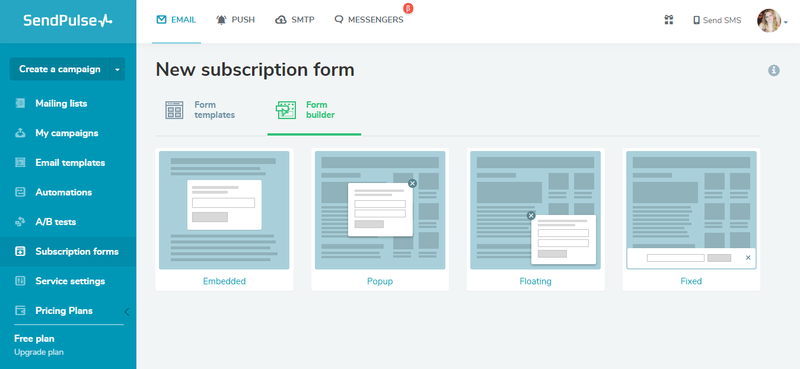
SendPulse lets you customize your forms to improve sign-up rate.
SendPulse not only lets you add as many custom fields as you like, you can also choose the type of forms, such as embedded or popup, change the layout from vertical to horizontal, edit the notification text customers receive when they sign up, and track the success of the form in generating signups.
Use lead management software
Lead management software — or a CRM solution that includes lead management functionality — can help you create segments by understanding which of your leads you should prioritize and which you don’t need to focus on based on your marketing metrics and goals.
Lead scoring — a key part of lead management — is a process that determines a customer’s readiness to buy. This is a numerical value that is worked out based on factors such as a customer’s engagement with your company and demographic data.
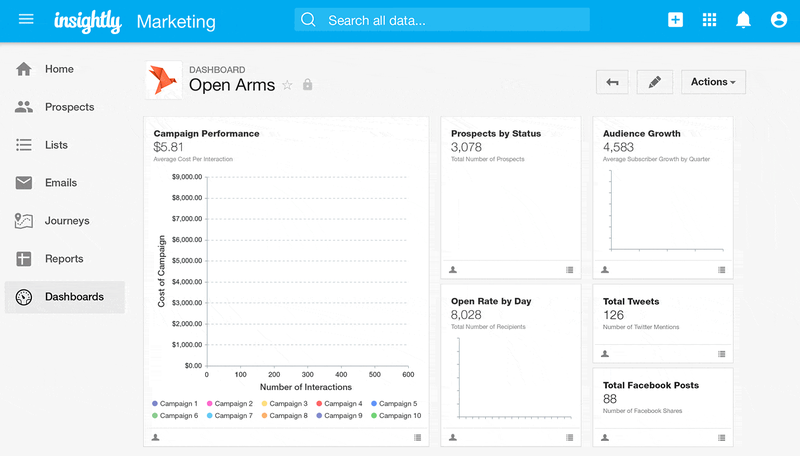
Insightly provides detailed information about the status of each lead.
Insightly has excellent lead management functionality, as its dashboard provides an at-a-glance view of the status of each lead. Once you’ve worked out which leads are a priority, you can create more accurate segments.
Automate the process
You can’t simply create segments and then just forget about them, but maintaining them manually is a time-consuming process. That’s why you need to invest in a direct marketing solution that comes with dynamic segmentation functionality.
Mailigen provides dynamic segmentation functionality, which means it automatically updates your segments as and when subscribers start and stop meeting your criteria.
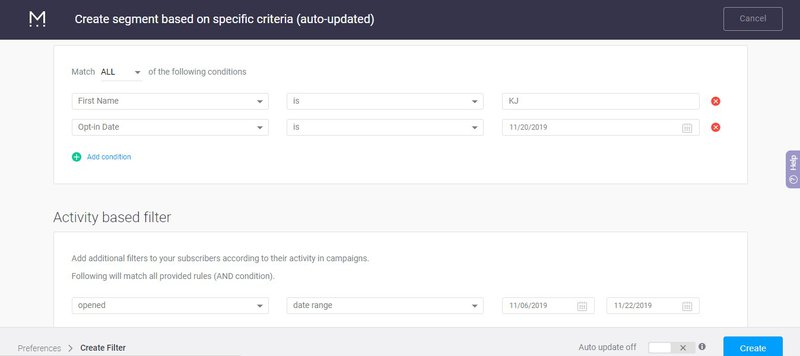
Mailigen automatically adds and removes people from your segments.
If a customer hasn’t clicked on any link in your newsletter, that person will be added to a “never clicked” segment. When they click on a link, they’ll be removed from that segment. If they don’t click again for a set period of time, they’ll be added to that segment again, and so on.
The more personalized and targeted, the better
Most people are inundated with emails and social media posts every day, without a hope of opening and looking at every one.
That’s why making sure all your emails and marketing messages are as personalized and relevant as they can be is key if you want to get your customers’ attention. Customer segmentation is crucial to being able to send the most relevant messages to your subscriber base.
Just make sure you’re keeping these segments up to date, retiring any that don’t serve you anymore, and creating and testing new ones on a regular basis.


